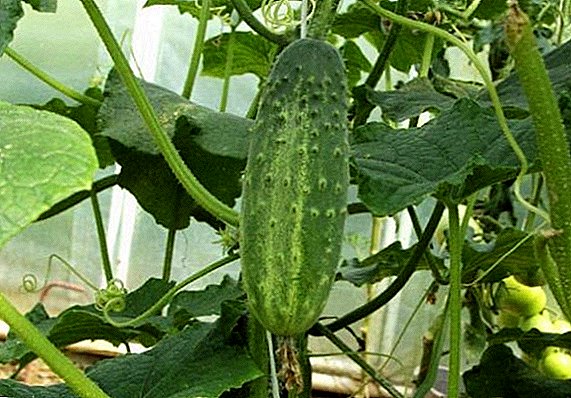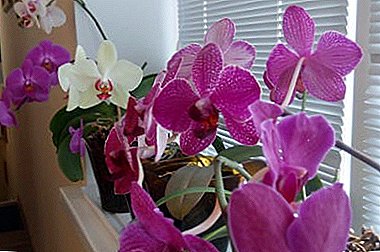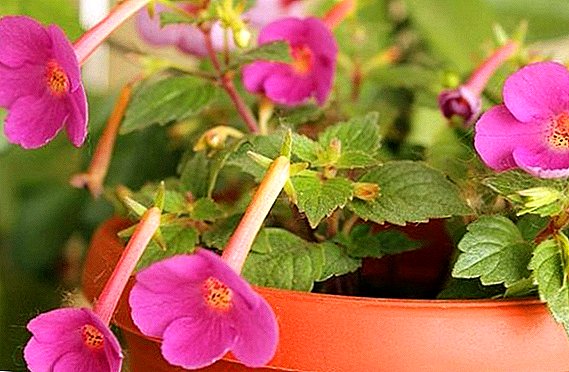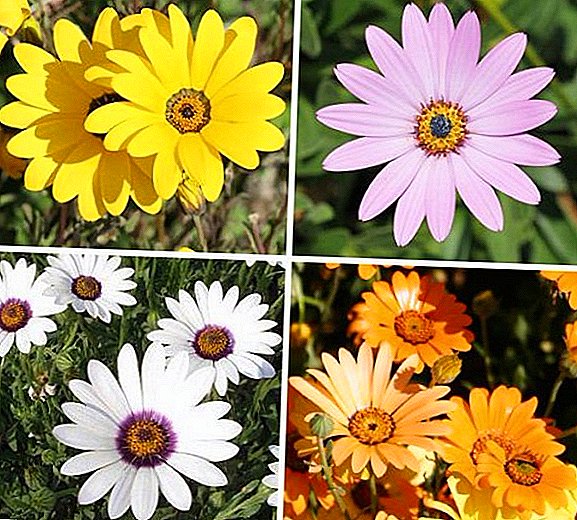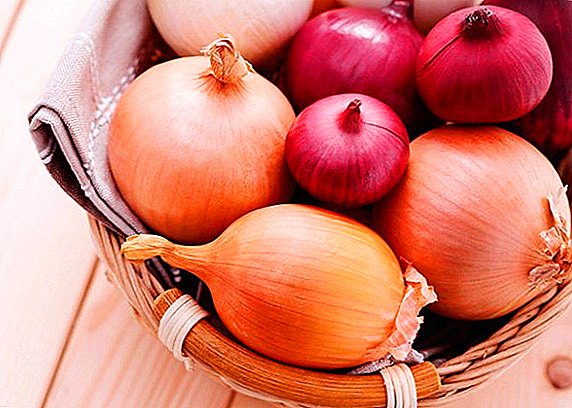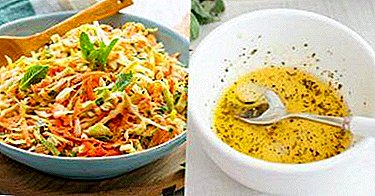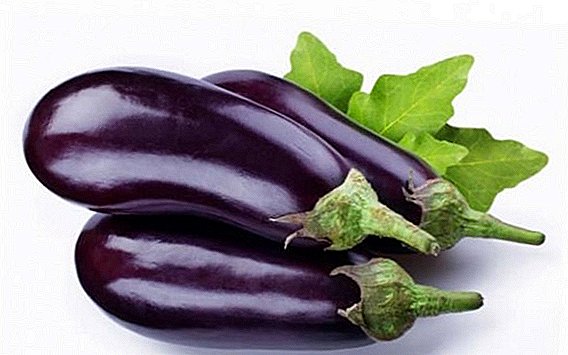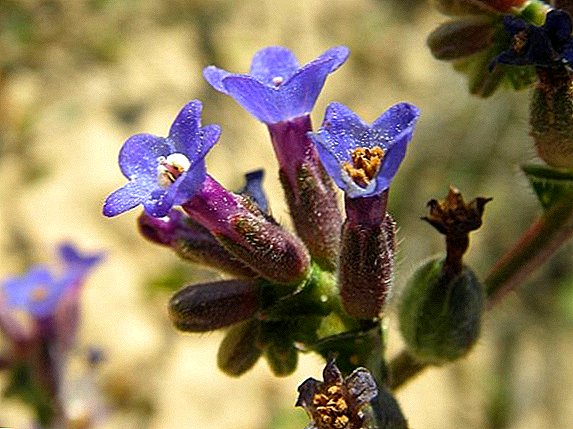 Many garden plants are very beautiful, but require constant care. The exception is such a plant as anhuzu or volovik - it is beautiful and very unpretentious. Learn how you can grow it at home and properly care.
Many garden plants are very beautiful, but require constant care. The exception is such a plant as anhuzu or volovik - it is beautiful and very unpretentious. Learn how you can grow it at home and properly care.
Botanical description
Anhuza is a perennial flower from the borage family, which can grow up to one and a half meters in height. The leaves of this flower are rather narrow, lanceolate, with longitudinal lines, arranged on erect thin stems that are covered with stiff, short hairs. Bullock's shoots branch quite strongly, often directly from the ground. The whole plant rests on a fibrous root system, which lies shallowly in the ground and does not have a pronounced root.
In addition to anhuzy, the family of borage also includes: onosma and forget-me-nots.

Appreciate this flower for its beautiful buds, which are collected paniculate or racemose inflorescences. They are formed from accrete leaves of a tubular or funnel-wheel-like corolla. The flower consists of 5 fused petals, the cross section of which resembles the blades. It grows up to 1.5 centimeters in diameter and can please with blue, white, dark blue or purple during its flowering period, which lasts from May to July. The heart of the flower is always a little different in color and flavor from the main petals. The smell from the flower comes intensely fruity.
Did you know? In the root system of volovik there is a significant amount of red coloring pigment, which is often used in cosmetology, and in Latin the name "Anhuza" means "make-up" or "cosmetics".The fruit of this plant is a nutlet of dark brown or gray color, which is tied immediately after the flower withers. The fruit is oval or egg-shaped and reaches a diameter of 5 mm. Anhuza is prone to self-sowing, and the seeds for a long time retain the ability to germinate.

Distribution and habitat
This flower in the wild nature often grows in the territory of Southern Russia, Western Asia, subtropical forests of Africa and America, and also it can often be found in the Mediterranean region. In ornamental floriculture volovik can often be seen in the gardens of Russia, Belarus and Ukraine. Volovik is distributed in sunny places where moderate humidity is present. This choice of place for growth is justified by the historical birthplace of the flower, so when using anhuzy in your garden, you should pay particular attention to the place of planting.
Popular types of Anhuzy
Among the species of volovik there are 38 items, but only some of them are used for decorative cultivation. The most popular volovik are the following:
- medicinal volovik. This type of anhuzy is grown as a honey plant and sown in the fields near apiaries. The plant is a biennial, during the flowering of which buds appear saturated blue. Buds grow as long, paniculate inflorescences approximately 10 centimeters long. This kind of cowhide is not just so called “medicinal”. Despite the fact that the plant is not used in the form of decoctions and compresses due to its toxicity, the substance allantoin is extracted from it, which is widely used in the pharmaceutical industry.
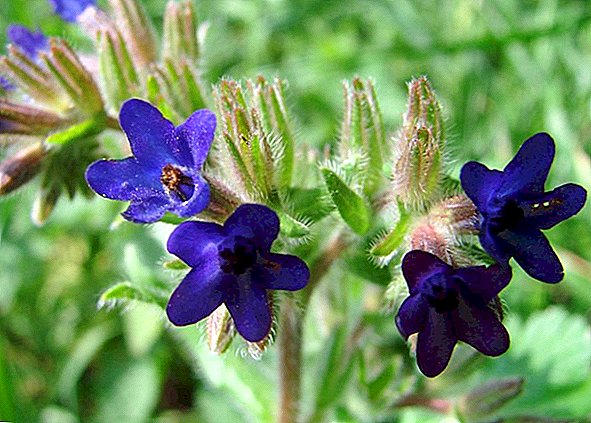
- Italian anhuza. This type of plant is used most often in floriculture for decorating plots. The Italian Cowhide is also known as the azure anhuza, it is a perennial plant with a fairly developed root system. Grows, on average, to 100 centimeters in height, the stems of this plant branch strongly and form wide shrubs that can reach 80 centimeters wide. The leaves have no decorative value, and the flowers of the Italian oxen are colored blue or light blue. Inflorescences are paniculate, but not thick.

- Anhuza Kap. This is a kind of annual volovikov, which are marked by a beautiful rich bloom. Most often in the wild, this species extends to the lands of subtropical and tropical regions of South Africa. Unlike biennial species, the Kapa Ankhuz forms low bushes (40-60 centimeters in height), the shoots of which are colored brown and are crowned with apical inflorescences, on which the blue labers are colored blue and reach one and a half centimeters in diameter. The centers of the flowers are painted white or lilac and protrude dome-shaped middle.
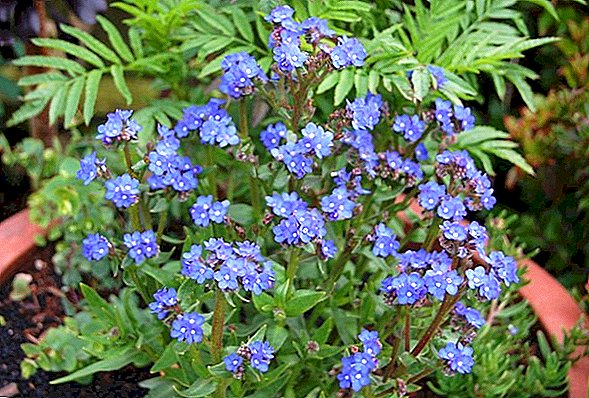
Did you know? Allantoin, obtained from this beautiful flower, is used in the manufacture of ointments for the treatment of sepsis, purulent wounds, trophic ulcers, and also, in the form of a colloidal solution, is used in the treatment of gastric and duodenal ulcers.Among the varieties of anhuzy are the most popular:
- Loddon Royalist. The shrub grows to 90 centimeters and is decorated with blue flowers.
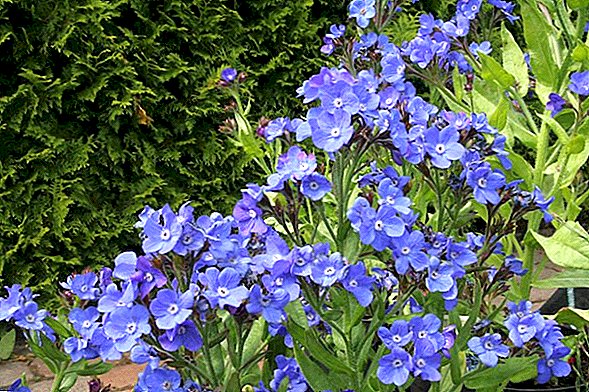
- Rowled Blue. Flowers have a light blue color.
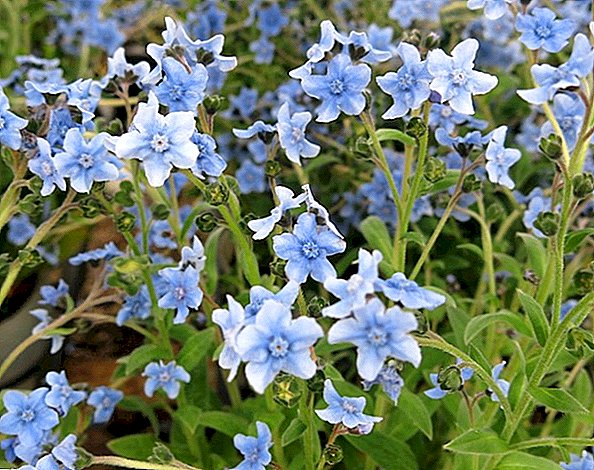
- A drop of summer. Saturated blue flowers with a snow-white core are decorated with reddish stalks of a bush that grows up to a meter in height.
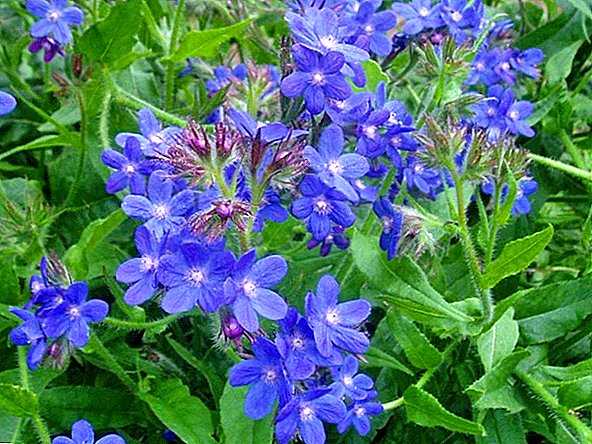
- Dropmore One of the highest representatives of the species, reaches one and a half meters in height, and its stems are crowned with flowers of a rich blue color.

- Dew drop A very popular variety, it reaches one and a half meters in height, but its distinctive feature is brown hearts of blue flowers.

- Alba This cowhide has snow-white flowers and is valued for its rare color by many growers.

- Blandin Blue. A low bush (up to half a meter), which is decorated with light blue flowers.
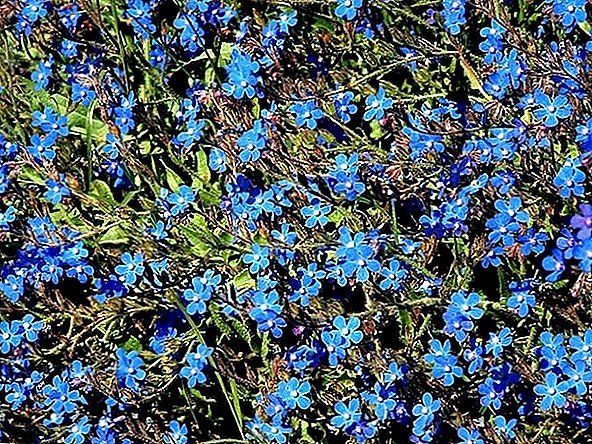
- Blue Angel. Very tiny bushes (up to 25 centimeters in height), the flowers of which have a rich blue color.
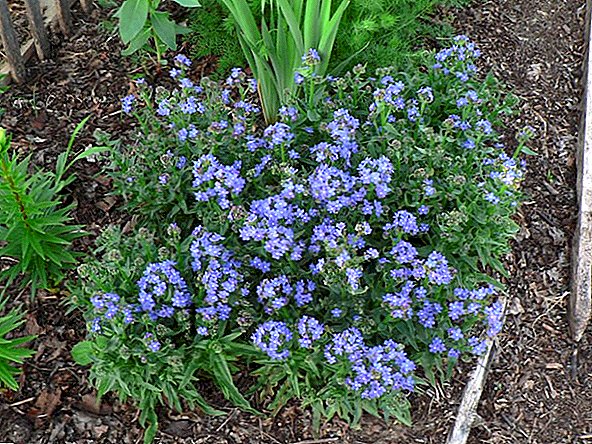
- Blue bird. Low bushes (up to 45 centimeters) that adorn the blue-purple flowers.

Use in landscape design
When planted on the site, Ankhuzu is used as a composite plant. It is well combined with such plants as: iberis, flax, primroses, thuja, daffodils, marigolds, Turkish carnation Albrus, gypsophila, rezuha.
Low-growing anhuzy varieties are planted in a solid carpet along curbs, paths, on hilly land and coastal areas (for example, near ponds). Also a wolfhound looks great in garden roccari as a single plant and on the balconies of houses.
The plant is good because with its help you can draw a beautiful flower bed, a solid carpet or even a separate line between the garden and the buildings on the site. 
Growing and caring for a plant with your own hands
We got acquainted with what a volovik is, and how it can be used in the design of our garden plot. We will understand the issue of growing, planting and caring for this flower.
Conditions of detention
Despite the fact that Anhuza is a rather resistant and unpretentious plant, you should responsibly approach the place where you will plant a flower. You need to stop your choice in sunny areas of the territory. Anhuza is planted in open ground, which must meet the requirements described below. If your variety is tall, you will need to install additional supports so that the wind does not bend the stem. In general, the flower does not require special care, because it is chosen by many gardeners who can not spend much time caring for flower beds.
As well as anhuza, sun-loving plants are also: young, carnation, Alpine aster, thyme, bell, sprat, stonecrop, edelweiss, sage (salvia) and geyhera.
 During growth, remove the flowering buds, in their place can grow new blue flowers.
During growth, remove the flowering buds, in their place can grow new blue flowers.Soil and fertilizer
For growing volovik, loamy or fertilized with humus, well drained, with a neutral level of acidity, warmed earth is best suited. The plant is drought-resistant, but you need to monitor the amount of water in the soil, and the best option would be moderately wet land. When planting anhuzy, be sure to fertilize the land with organic fertilizer (compost or humus) and dig the beds. To maintain active breeding of buds once in the summer, complex mineral and organic supplements can be applied to the soil.
To enrich the soil and nourish the plants, use organic fertilizers: straw, pigeon droppings, Florex granulated chicken droppings, bone meal, fish meal, whey, potato peel, compost, eggshell, banana peel fertilizer and tobacco dust.
Watering and moisture
Watering is carried out on dry days. Make sure that the earth is not too wet, as excessive moisture can cause rotting of the flower legs. 
Familiarize yourself with the advantages of using drip irrigation, as well as learn how to organize a system of drip irrigation at the dacha.
Reproduction and planting
Choosing a place where your ankhuz will grow, as well as having done the necessary work on soil preparation (fertilizer, drainage, moistening), you can proceed directly to planting flowers. Volovik plant in the spring, and by May it blooms. But there are two main ways of breeding plants that can be used for decorative purposes.
Seeds
Using seeds when breeding volovik, you can go two ways: plant them immediately in the prepared open soil, or resort to growing seedlings. Differences in the choice of sowing tactics are in climatic conditions, where seeds will germinate.
Important! When preparing for winter, annual plants should be cut at the root, and the stem can be used as compost.If you grow anhuzu in the southern warm areas, then resort to the first method. Prepare small beds on prepared fertilized soil. In the fertilized soil, sow the seeds of volovik, either late in the fall before the onset of the first snow, or in early spring, when the first snow has just melted. The first shoots will be visible in mid-April. During the ascent you need to monitor the good water permeability of the beds. When the first seedlings have sprouted, they can be transplanted to a permanent place of growth.

Carry out this procedure should be carefully, so as not to harm the root system of the flower. When planting young shoots, keep the distance between the bushes (it should be 20 centimeters). After all the actions that have been carried out, the flowering of a cowhide can be expected from July to September, next year the anhuza will bloom in the usual period from May to July.
If you are in cooler areas, then the logical solution would be to resort to growing seedlings. In early March, you need to prepare the boxes with a mixture of peat, earth, humus and sand. In this substrate it is necessary to sow the seeds shallowly, cover the boxes with film and leave it in a cool, well-lit place. The temperature in the room when climbing shoots should be between 16 ° and 20 °. The first shoots will appear by the beginning of April, but it will be possible to plant them in separate pots only if there are several leaves. Grown seedlings in open ground can be planted in late May. 
Vegetative
This method of reproduction is best applied to perennial plants. The essence of vegetative propagation is to separate from the main plant the part that can sprout on its own. Anhuzy shrubs propagate in this way: in autumn or late spring, in rainy and warm weather, the mother-branch of a volovik is dug out. The plant is dug up from the root, and then divided into the rooted way into several parts so that the stem with the root remains. Immediately after such a division, the delenki can be seated in separate places where they will grow further.
Relation to temperature
Volovik is a rather cold-resistant plant, it can safely winter without special shelters and preparations. For the normal life cycle, the ankhuz has enough wintering under the snow, but if the winter was not enough snow, then the cowhide can be covered with a layer of lapnik.
Plants such as lilac, spirea, white deren, barberry, mountain ash (red), viburnum and wild cherry are as well as anhuzy, frost-resistant and will be able to withstand the harsh winter with confidence and without problems.

Volovik easily tolerates dry weather and does not require frequent careful watering. Such measures (frequent soil moistening) are needed only in the case of active growth of fragile seedlings.
Possible difficulties in growing
It is necessary to immediately take into account the fact that planting perennial cowhide, do not need to rely on its flowering in the first year of growth. Perennials bloom only for the next season after disembarkation.
Important! In order to grow a cowhide better and be less susceptible to diseases, it is better to treat the root separation sites with wood ash or crushed activated carbon.It is imperative to organize a drainage layer in the ground so that the excess water does not cause rotting of the roots and stalks of the volovik. Be sure to comply with the rules of watering: for the wolf is considered optimal watering twice a week.
 Drainage clay
Drainage clayVolovik has a tendency to self-sowing, and the fruits are tied immediately after the flower withers. In order to prevent uncontrolled spreading, wilted buds should immediately be plucked.
Important! You should work with ankhuz only in gloves, because this flower is poisonous.
Pests, diseases and prevention
The main problems are powdery mildew, as well as attempted aphids. In order to fight with powdery mildew, it is enough to treat the damaged area of anhuzy with a solution of laundry soap and alcohol. You can notice the disease as follows: the bullock shoots began to bend. 
Only special insecticides can help against aphids, and damaged areas are simply removed and burned.
As a preventive measure, you can use insecticide spraying and regularly inspect shoots to remove damaged parts of the plant in time.
Anhuza is a beautiful flower that does not require careful care and a lot of effort. But it is worth remembering that because of its poisonousness, it is necessary to carefully handle it: you should not allow children and animals to the cowhide, and when working with a plant, always protect the skin.
Video: Anhuza
Reviews from the network about ankhuz



















